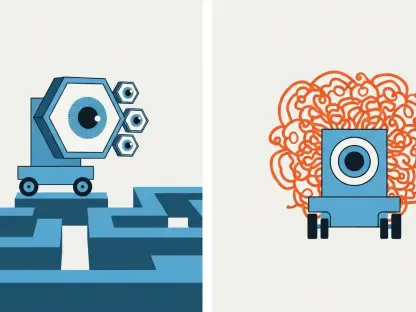In the heart of Downtown Chicago, a tragic and violent incident on a sunny June day in 2021 shook the community when Anat Kimchi, a 31-year-old graduate student from the University of Maryland, was fatally stabbed in an unprovoked attack near Wacker Drive and Van Buren Street. The accused, Tony Robinson, a 45-year-old man grappling with homelessness and mental health issues, has also been linked to assaults on two other women in the South Loop during the same period. This case, marked by its brutality, has taken a significant turn in the courtroom, drawing attention not only for the crime itself but for a pioneering legal challenge against the use of facial recognition technology by the Chicago Police Department (CPD). As this technology becomes a focal point in identifying Robinson as the suspect, the defense’s pushback could potentially reshape how such tools are viewed in criminal investigations across Cook County and beyond, sparking a broader debate about justice and innovation.
Legal Battle Over Technology
Facial Recognition Under Scrutiny
The deployment of facial recognition technology by the CPD, a practice spanning over a decade, has come under intense examination in this high-profile murder case. The process involved taking a still image from an officer’s body camera footage after the incident and running it through a database to pinpoint Robinson as the suspect. However, the defense, represented by attorneys from the Cook County Public Defender’s Office, contends that this technology is riddled with flaws, particularly its documented inaccuracies when identifying nonwhite individuals. Labeled as a “black box” due to its opaque methodology, the lack of transparency in how matches are determined raises serious concerns about reliability. This courtroom challenge, possibly the first of its kind in Cook County, could set a critical precedent for future cases, questioning whether such tools can be trusted as primary evidence in the pursuit of justice.
Beyond the technical shortcomings, the defense highlights specific issues with the identification process in this case that amplify doubts about the technology’s validity. Attorney Quandee Semrow has pointed out that an eyewitness failed to recognize Robinson in a photo lineup featuring the body camera image, suggesting potential errors or bias in the system. This failure casts a shadow over the integrity of the investigation, as the defense argues that reliance on such a tool may have prematurely directed suspicion toward Robinson. The broader implications of this argument touch on ethical concerns, as the technology’s error rates could disproportionately affect marginalized groups, leading to wrongful accusations. As this legal battle unfolds, it brings to light the urgent need for oversight and standardized guidelines to ensure fairness when advanced tools are used in criminal proceedings.
Prosecution’s Strong Evidence
Despite the heated debate over facial recognition, the prosecution remains steadfast in their assertion that the case against Robinson is robust, supported by a wealth of alternative evidence. Video footage captured during the incident provides a detailed account of the events, showing Robinson allegedly discarding a shirt shortly after the attack. Subsequent testing revealed a 98% DNA match to Robinson on the garment, offering a tangible link to the crime. This physical evidence, combined with the visual record, forms a compelling narrative that the state believes can stand independently of the contested technology. Assistant State’s Attorney Anna Sedelmaier has emphasized the strength of these elements, suggesting confidence in securing a conviction regardless of the defense’s challenge.
Adding further weight to the prosecution’s position is the testimony of a witness from a homeless encampment on Lower Wacker Drive who identified Robinson in a physical lineup. Unlike the earlier photo lineup failure, this direct recognition by someone familiar with Robinson from the local community bolsters the state’s case significantly. This identification, grounded in personal acquaintance rather than algorithmic output, offers a human element that contrasts with the impersonal nature of facial recognition. The interplay between traditional and modern investigative methods in this case raises intriguing questions about whether the challenge to technology will ultimately influence the court’s decision, or if the sheer volume of corroborating evidence will render the debate a secondary concern in the eyes of the judiciary.
Public Safety and Societal Issues
Violent Crime in Downtown Chicago
The tragic killing of Anat Kimchi is not an isolated event but rather a stark reminder of a troubling pattern of violent crime plaguing Downtown Chicago. Investigations into similar incidents have revealed a disturbing trend, often involving individuals who exhibit signs of untreated mental illness. This case, brought to public attention through extensive reporting, underscores a critical challenge for city officials and law enforcement: balancing the need for immediate community safety with addressing the root causes of such violence. The randomness and brutality of attacks like the one on Kimchi heighten public anxiety, prompting calls for enhanced security measures and proactive strategies to prevent future tragedies in bustling urban centers where residents and visitors alike expect a sense of security.
Moreover, the concentration of violent incidents in specific areas like Downtown Chicago points to systemic issues that transcend individual acts of crime. The intersection of poverty, lack of resources, and insufficient intervention programs often creates environments where desperation can lead to aggression. Community advocates argue that without comprehensive reforms, including better access to social services, the cycle of violence will persist. This case serves as a catalyst for broader discussions on urban safety policies, pushing stakeholders to consider innovative solutions that prioritize prevention over reaction. As the legal proceedings continue, the spotlight on these recurring attacks may drive meaningful dialogue and action to protect vulnerable populations and the public at large.
Mental Health and Homelessness
Tony Robinson’s personal history sheds light on the profound challenges of mental health and homelessness, which are often intertwined with incidents of violence in urban settings. Living in a tent under Lower Wacker Drive, Robinson’s documented struggles with paranoia and erratic behavior, as reported by police, paint a picture of a man in dire need of support long before the tragic events unfolded. His case exemplifies how untreated mental illness can exacerbate vulnerability, sometimes leading to catastrophic outcomes for both the individual and the community. This narrative compels a closer examination of how society addresses mental health crises among the homeless, a demographic frequently overlooked until tragedy strikes.
The societal implications of Robinson’s background extend beyond this single case, highlighting a glaring gap in care systems designed to assist those in crisis. Many argue that early intervention, access to psychiatric care, and stable housing could prevent escalations that result in violence. In Chicago, where harsh winters and economic disparities compound the struggles of the homeless, the need for robust outreach programs is evident. This situation challenges policymakers to rethink resource allocation, ensuring that mental health services are not just reactive but preventive. As this case progresses, it serves as a poignant reminder of the human cost of systemic neglect, urging a compassionate yet practical approach to address these intertwined issues before more lives are lost.
Judicial Perspective and Case Progression
Judge’s Ruling and Community Risk
In navigating the complexities of this case, Cook County Circuit Judge John F. Lyke has taken a firm stance on public safety, denying Robinson’s pretrial release due to the severity of the alleged crimes. Labeling Robinson a “real and present threat” to the community, the judge’s ruling reflects a prioritization of protection over individual liberty in light of the violent nature of the attacks. This decision underscores the gravity of the charges, as the court grapples with ensuring that justice serves not only the victims but also the broader public interest. The emphasis on community risk highlights the judiciary’s role in balancing legal challenges with the immediate need to prevent further harm during ongoing proceedings.
Additionally, Judge Lyke’s skepticism regarding the defense’s focus on facial recognition technology suggests a pragmatic approach to the case’s legal nuances. Describing the challenge as potentially a “moot exercise” in the face of substantial other evidence, the judge appears to prioritize the cumulative strength of the prosecution’s arguments over a singular investigative method. This perspective indicates that while technological debates are noteworthy, they may not overshadow the core facts of the crime in the court’s final analysis. As such, the ruling sets a tone of caution and responsibility, ensuring that the legal process remains focused on safeguarding society while addressing innovative concerns in a measured manner.
Ongoing Legal Proceedings
The continuation of this case until October for further testimony on the application of facial recognition technology marks a pivotal moment in the intersection of law and innovation. The outcome of this legal scrutiny could establish a benchmark for how such tools are contested and validated in courtrooms across Illinois and potentially nationwide. As both sides prepare to delve deeper into the reliability and ethical implications of the technology, the proceedings promise to offer critical insights into balancing cutting-edge investigative methods with the fundamental principles of fairness and accuracy. This ongoing battle is poised to influence future policies on the integration of advanced tools in law enforcement practices.
Furthermore, the unfolding legal drama surrounding Robinson’s case serves as a microcosm of larger debates about modern policing and justice. The defense’s push for transparency and accountability in how facial recognition is applied resonates with growing public and legal concerns about privacy and bias. Meanwhile, the prosecution’s reliance on traditional evidence alongside technology reflects an evolving landscape where old and new methods must coexist. As testimony continues, the resolution of these issues will likely provide a framework for navigating similar challenges, ensuring that the pursuit of justice adapts to technological advancements without compromising integrity or public trust.









